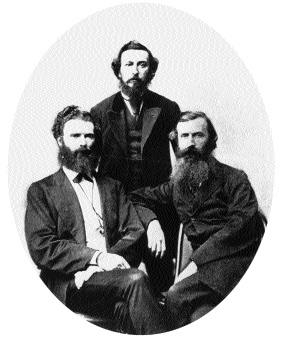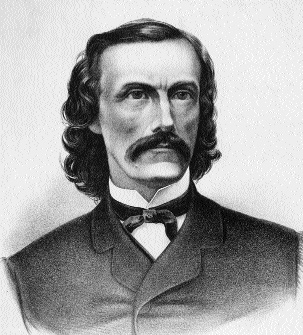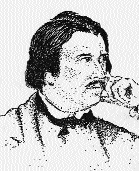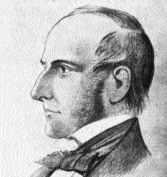Cappoquin & the 1849 Movement
Published in 18th–19th - Century History, Features, Issue 2 (Summer 1999), Volume 7
Dennis Mulcahy, Thomas Clarke Luby and John O’Leary-many later prominent Fenians were involved. (Kilmainham)
The Young Irelanders’ rhetoric of rebellion was not matched by their actions and it is easy to dismiss their efforts as ‘Widow McCormack’s cabbage patch’. If Smith O’Brien’s failure to attract significant support had been the only attempt during that year, the sword may have been consigned to history. The efforts of John O’Mahony are normally ignored. His seven-week campaign on the Comeragh Mountains involving attacks on the police barracks at Aheny, Glenbour and finally Portlaw in September 1848 is almost entirely forgotten. The arrests of 118 Young Irelanders following the suspension of habeas corpus, combined with numerous other arrests on specific charges have also escaped analysis. It was O’Mahony’s limited success that was to influence a small group of nationalists that had their followers been ‘properly organised and led by a sufficient number of skilled officers, they could, even with scanty armament, have inaugurated a formidable insurrection…’. This naïve attitude was to colour the design of a new conspiracy which would lead to the attack on the police barracks at Cappoquin in September 1849.
Rebels re-group
The origins of the new movement were not due to the efforts of one individual. The leaders were to include those released from prison and others who had avoided capture. Fintan Lalor, often credited with the movement’s leadership, was only one of a number undeterred by his spell in prison. On his release, he wrote to Gavan Duffy who was still in prison that ‘I am urged by several parties of different shades of green, to join them in a new movement’. Duffy had probably already decided that any further effort was useless and rebuffed all advances. One of the parties at the core of the new conspiracy were former members of the Swift Confederate Club and included their former secretary, Philip Grey. Grey had been with O’Mahony in 1848 and was behind the failed attempt to rescue the Young Ireland leaders from Clonmel Jail in November 1848. The attempt had been betrayed due to the ‘perfidy of the usual informer’ and though Grey avoided capture his young lieutenant John O’Leary spent a few weeks in Clonmel Jail usefully contacting other Young Irelanders. On his release, he again joined Grey and began to assist him to create the framework of the movement. The other leader who was to play a prominent role in the events at Cappoquin was Joseph Brenan. He had been arrested under the suspension of habeas corpus, but on his release he returned to his journalistic activities becoming co-editor of The Irishman. The various small groupings merged into one following a meeting in a field near Rathmines church early in 1849. Unfortunately conflicts of personality and ambition between Brenan and Lalor were to weaken the structure.
The Government was not unprepared for further problems. The Resident Magistrates of those counties proclaimed had been circulated by questionnaire late in 1848 to assess what was the level of ill-feeling in their counties and to what extent the population had shown any sign of repentance. The replies vary considerably but offered enough evidence of continued discontent for Lord Clarendon to appeal to parliament to continue the suspension of habeas corpus. In private he believed that the winter of 1848 would be ‘characterised by banditti warfare against property and by a struggle between ruined landlords and tenants for the insufficient produce of the soil’. In much of his correspondence at the time he made the careful distinction between agrarian outrage, which seems to be accepted as almost normal, and ‘political’ actions which were potentially more dangerous.
Organised by committee
The new conspiracy was organised by committee and lacked clear leadership, a situation ripe for disputes between members. The source of dispute between Lalor and Brenan was over the former’s idea to publish a new radical paper. This had no appeal for Brenan, but he was unable to prevent Lalor from pursuing his plans: he busily contacted former associates including Father Kenyon, but he too steered clear of any involvement. There were clear instructions from the bishops against involvement in political conspiracies, though the tenant right campaign did attract clerical participation. Many local parish priests were actively preaching against further secret organisation. Early indications of the spread of a new movement came in February 1849 when the parish priest of Irishtown, Clonmel, dismissed two employees for being members. In March the Resident Magistrate in Waterford was advising the government of rumours of a renewed conspiracy, though its exact nature was as yet uncertain. The development of the movement seems to have rested on agents sent from Dublin to contact groups of sympathisers’, ex-confederates and defenders. The actions of these agents were conducted in secrecy and they may have restricted the active membership to unmarried men.

John O’Mahoney’s seven-week campaign in 1848 on the Comeragh Mountains is normally ignored. (Currier and Ives)
Lalor embarked on one of these missions in June 1849 accompanied by Thomas Clark Luby. He visited both Tipperary and Limerick writing a series of excited letters to Dublin proclaiming his success. His enthusiasm may have been misplaced—a Limerick RM wrote: ‘I have been for some time aware of his being in this locality. I have had him watched. He is associated with a man called Meany and both endeavoured to gain converts…I believe without any success whatever. I know one instance where they were turned out, and their overtures rejected and that by a party who last year would have received them with open arms.’ In Lalor’s absence Brenan had the chance to assert his leadership over the movement.
Plan to kidnap Queen Victoria
The conspirators had already been approached to attempt a rescue of the Young Irelanders awaiting transportation in Dublin and were only deterred by a letter from John Martin. In August the visit of Queen Victoria presented an opportunity to act. On an evening whilst the royal party was in Dublin a group of about 200 gathered on the banks of the Royal Canal to attempt a kidnap. Being poorly armed and surprised by the police the attempt was abandoned. Brenan had however already sent messages to groups in the country to be prepared to rise and the failure to rise was to shake the confidence of local groups in the leadership’s abilities. The government did make at least one arrest, but the chief concern of the administration focused on the political uproar caused by the Dolly’s Brae incident in July. They were also besieged with appeals for the pardon of Smith O’Brien and the other Young Ireland leaders. The new conspiracy was not taken very seriously as the government was certain that their efforts would not mature into a serious threat. Clarendon had more respect for the abilities of the ‘astute editor’ of The Nation, Gavan Duffy, who had relaunched the paper after his acquittal.
In September the conspirators, determined not to let the year pass without some attempt, met at Clonmel. The meeting included delegates from all the eighteen active branches representing about a thousand supporters. The attempt may not have gone ahead if it had not been for the assurances of Rody O’Bourke of Glenbreda that he could lead a thousand men into the field. At a second meeting the final plans were made for a rising on Sunday, 16 September, involving attacks on a number of garrison towns in Tipperary and Waterford, followed by further attempts in Cork, Limerick and Kilkenny.
The failed ‘rising’
To call what followed a rising is certainly a misuse of the term. Various small groups gathered on the night of 16 September at different locations in Tipperary, but bad weather and insufficient numbers led to the abandonment of any attempt. Local police and magistrates had received reports of such gatherings and there were arrests of those caught armed with pikes. In some areas supporters could not be persuaded to rise at all and were ‘not able to remain in their houses at night for fearing that they may be made to go with the rebels’.

Joseph Brenan

James Fintan Lalor
At Cappoquin the story was somewhat different. Brenan had travelled to the town that morning making contact with the Young Irelander and native of Cappoquin, Michael Cavanagh. In the company of Cavanagh they succeeded in alerting groups of supporters both within the town and surrounding country who gathered on that evening to attempt to surprise the police barracks. They succeeded in maintaining an element of secrecy up to a half-hour before the attack, when an old woman of the town warned the police constable on patrol to be careful. This ‘secret information’ was enough to warn other officers and place the barracks in readiness. He had left to inform his officer when the attack occurred. There followed a brief exchange of fire which left one attacker dead and caused the others to disperse. In their retreat they encountered a foot patrol of two other officers who had not been warned. One escaped, but sub-constable James Owens was severely wounded and left for dead in the street. He was to die of his wounds the following day.
A potential serious attempt took place at Dungarvan. Here the conspirators had the support of a corporal and two privates of the garrison who were to be on guard duty that night. Fortunately for the garrison, the conspirators in the town were not joined by those expected from the country areas. The government soon hurried reinforcements to the area. Two companies of the 7th Fusiliers were sent to Cappoquin, whilst the 39th Regiment was put in readiness in England should it be required. The conspirators themselves remained active until at least two weeks after the failed rising before abandoning all further attempts. In Cappoquin and the Dungarvan area there were a series of arrests during this period mainly on the evidence of an approver, but all the major conspirators escaped. This left the authorities uncertain as to whether or not the attack at Cappoquin had had a political motive at all and they also lacked sufficient evidence to prove a wider conspiracy. At two assizes in Waterford the following year the attackers were tried under the Whiteboys Act and eleven were sentenced to transportation, some to Australia, others to Bermuda.
Undeservedly forgotten
Lalor, his health damaged by a wet night spent in a ditch outside Clonmel, reluctantly returned to Dublin where he wrote to Gavan Duffy complaining that ‘the coffin lid has closed on the last hope of the living generation’. He died on 27 December 1849. Brenan, along with various local men from Cappoquin including Cavanagh, fled to America. There, between bouts of ill-health, Brenan was active in journalism before his death in New Orleans in May 1857. Philip Grey also died in 1857 following an active period working with Luby on The Tribune and at a point when Stephens was preparing the ground for the formation of the Fenian movement. The early deaths of these three leaders has probably helped to place the movement and attack at Cappoquin outside the active memory of nationalists. The whole movement would have had no significance were it not for the fact that many later prominent Fenians were involved. Apart from O’Leary and Luby, Dennis Mulcahy was active and sheltered Brenan in his flight. The Dublin conspirators met at various locations including Peter Langan’s in Lombard Street. Michael Cavanagh who returned to Ireland with the body of Terence Bellew McManus was the secretary to John O’Mahony and biographer of Meagher. There are other links in personnel. The parallels in secret organisation, the subversion of military personnel and tactical plan are apparent. It was even reported at the time that the group had received American finance. The prominence of Lalor as a political theorist has led to his works appearing in a number of editions, one of which by L. Fogarty, proscribed when published in 1918, is prefaced by Arthur Griffith. In describing the events of 1849 he wrote: ‘It gave him [Lalor] the opportunity he desired to teach the country that the end of endeavour had not been reached in ‘forty-eight and that to venture nobly was better, almost, than to triumph’—a message addressed to the contemporary political situation.
In Cappoquin there is no monument to the attack apart from a terrace of houses named after James O’Donoughue, the attacker killed. It might be invidious to make a distinction between policemen killed by nationalists and others killed as a result of agrarian outrage, however a good case can be made for James Owens as the first officer killed as a result of nationalist actions. He is buried close to O’Donoughue at Affane. Nobody was prosecuted for his murder, due to lack of evidence but also as a result of government embarrassment over the Dolly’s Brae incident. None of those transported served the full term. There were no martyrs, no songs composed in their memory. Poor Owens was left as an acceptable casualty in a bleak period of Irish history.
Anthony M. Breen lectures in history at the University of East Anglia.
Further reading:
A.M. Breen, The Cappoquin Rebellion 1849 (Suffolk 1998).
R.V. Comerford, The Fenians in Context: Irish politics and society 1848-1882 (Dublin 1998).
















